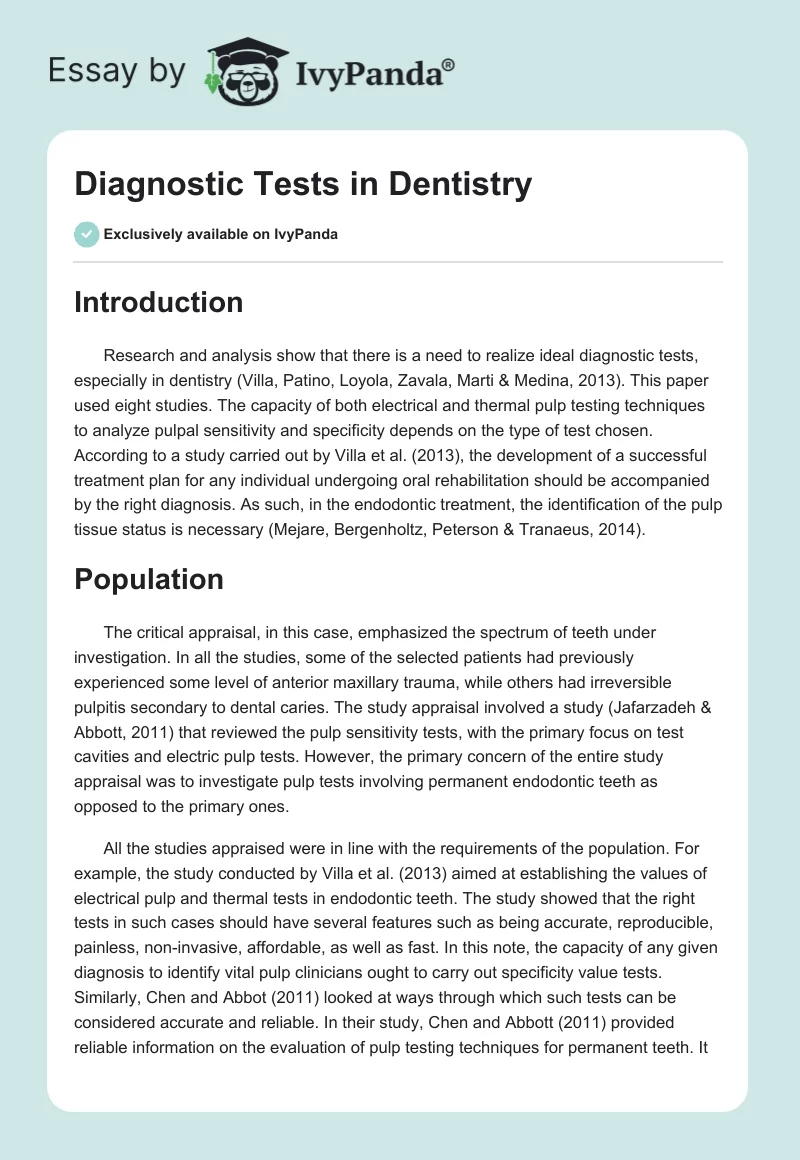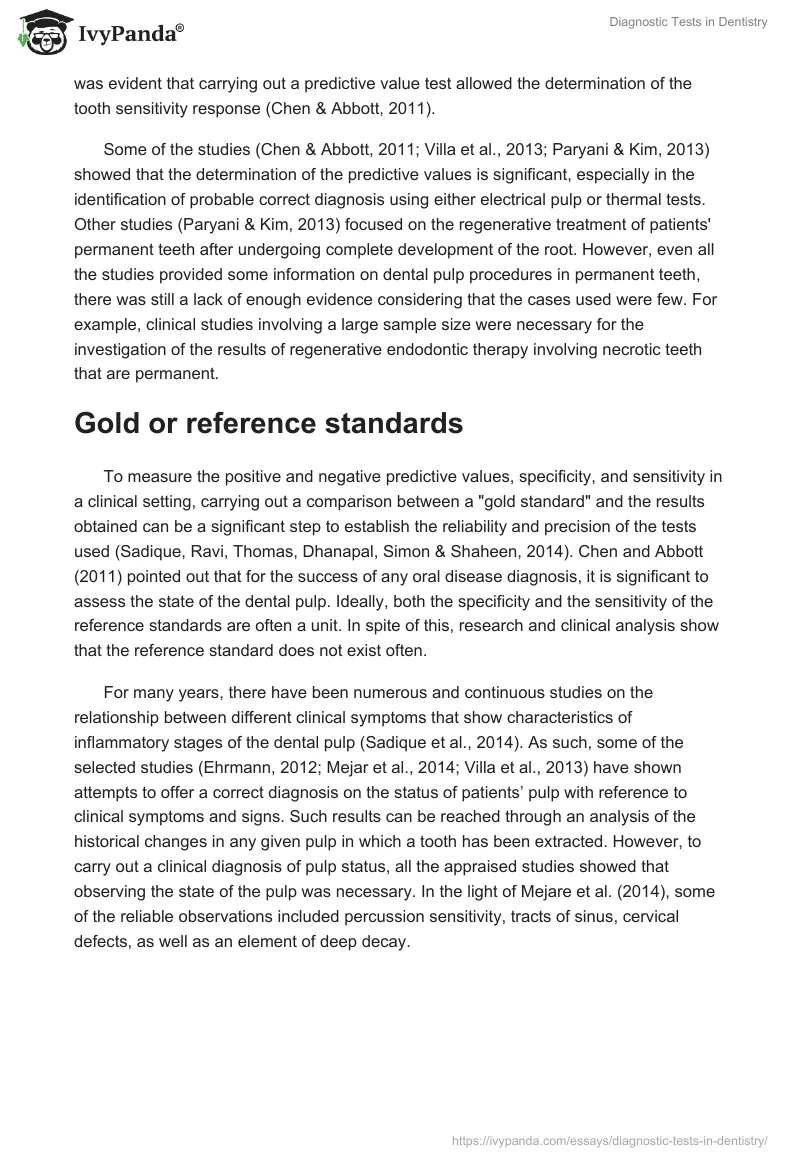Introduction
Research and analysis show that there is a need to realize ideal diagnostic tests, especially in dentistry (Villa, Patino, Loyola, Zavala, Marti & Medina, 2013). This paper used eight studies. The capacity of both electrical and thermal pulp testing techniques to analyze pulpal sensitivity and specificity depends on the type of test chosen. According to a study carried out by Villa et al. (2013), the development of a successful treatment plan for any individual undergoing oral rehabilitation should be accompanied by the right diagnosis. As such, in the endodontic treatment, the identification of the pulp tissue status is necessary (Mejare, Bergenholtz, Peterson & Tranaeus, 2014).
Population
The critical appraisal, in this case, emphasized the spectrum of teeth under investigation. In all the studies, some of the selected patients had previously experienced some level of anterior maxillary trauma, while others had irreversible pulpitis secondary to dental caries. The study appraisal involved a study (Jafarzadeh & Abbott, 2011) that reviewed the pulp sensitivity tests, with the primary focus on test cavities and electric pulp tests. However, the primary concern of the entire study appraisal was to investigate pulp tests involving permanent endodontic teeth as opposed to the primary ones.
All the studies appraised were in line with the requirements of the population. For example, the study conducted by Villa et al. (2013) aimed at establishing the values of electrical pulp and thermal tests in endodontic teeth. The study showed that the right tests in such cases should have several features such as being accurate, reproducible, painless, non-invasive, affordable, as well as fast. In this note, the capacity of any given diagnosis to identify vital pulp clinicians ought to carry out specificity value tests. Similarly, Chen and Abbot (2011) looked at ways through which such tests can be considered accurate and reliable. In their study, Chen and Abbott (2011) provided reliable information on the evaluation of pulp testing techniques for permanent teeth. It was evident that carrying out a predictive value test allowed the determination of the tooth sensitivity response (Chen & Abbott, 2011).
Some of the studies (Chen & Abbott, 2011; Villa et al., 2013; Paryani & Kim, 2013) showed that the determination of the predictive values is significant, especially in the identification of probable correct diagnosis using either electrical pulp or thermal tests. Other studies (Paryani & Kim, 2013) focused on the regenerative treatment of patients’ permanent teeth after undergoing complete development of the root. However, even all the studies provided some information on dental pulp procedures in permanent teeth, there was still a lack of enough evidence considering that the cases used were few. For example, clinical studies involving a large sample size were necessary for the investigation of the results of regenerative endodontic therapy involving necrotic teeth that are permanent.
Gold or reference standards
To measure the positive and negative predictive values, specificity, and sensitivity in a clinical setting, carrying out a comparison between a “gold standard” and the results obtained can be a significant step to establish the reliability and precision of the tests used (Sadique, Ravi, Thomas, Dhanapal, Simon & Shaheen, 2014). Chen and Abbott (2011) pointed out that for the success of any oral disease diagnosis, it is significant to assess the state of the dental pulp. Ideally, both the specificity and the sensitivity of the reference standards are often a unit. In spite of this, research and clinical analysis show that the reference standard does not exist often.
For many years, there have been numerous and continuous studies on the relationship between different clinical symptoms that show characteristics of inflammatory stages of the dental pulp (Sadique et al., 2014). As such, some of the selected studies (Ehrmann, 2012; Mejar et al., 2014; Villa et al., 2013) have shown attempts to offer a correct diagnosis on the status of patients’ pulp with reference to clinical symptoms and signs. Such results can be reached through an analysis of the historical changes in any given pulp in which a tooth has been extracted. However, to carry out a clinical diagnosis of pulp status, all the appraised studies showed that observing the state of the pulp was necessary. In the light of Mejare et al. (2014), some of the reliable observations included percussion sensitivity, tracts of sinus, cervical defects, as well as an element of deep decay.
Execution of the index tests and reference standards
It was necessary for all the studies to show whether replication of the study was necessary while carrying out the index tests (Jafarzadeh & Abbott, 2011). However, only a few studies provided sufficient information on the methods of index execution. In their study, Chen and Abbott (2011) compared the repeatability, reliability, and clinical accuracy of an Electric Pulp Test (EPT), LDF (Laser Doppler Flowmetry), as well as other types of thermally driven pulp sensitivity tests. In this study, the thermal tests made the use of Endo Frost, carbon dioxide, and ice but within a given interval. The mean flow of blood within the pulp was measured using a Doppler flowmeter. In spite of the fact that the electric pulp tests and cold tests are patient-dependent and subjective, they are the best examples of sensitivity tests that are used in assessing the state of individuals’ pulp.
However, the appraisal pointed out that most of the pulp sensitivity tests were mired with many limitations. For example, the Electric Pulp Tests are not reliable in cases involving teeth that are not mature since there are likely occurrences of false responses, especially at the conduction of electric current through the periodontal tissues.
Investigators and Blinding
Clinical analysis requires that the investigators involved in any form of reference or gold standard and index tests do not have prior knowledge of the health of the pulp before carrying out the necessary information. In addition, other information such as previous results on pulpal investigation should not be available to the investigators before they examine the state of the teeth. Thus, pulp tests require total blinding of the investigators because such strategies are necessary for avoiding chances of study bias. Such cases can be expected considering that the investigators may work to manipulate results to match those of previous studies for which they had prior information.
According to studies by Chen and Abbott (2011); Setzer, Kataoka, Natrielli, Gondim-Junior, and Caldeira (2012), there have been extensive studies on the use of laser Doppler flowmetry, specifically in cases involving traumatized pulps.
All the studies in endodontic diagnosis revealed that diagnostic processes make use of dental history analysis, radiographs, clinical inspection, electrical and thermal sensitivity tests. During the electrical and thermal sensitivity tests, the affected person is likely to experience pain because the procedures stimulate the nerve endings in the dental pulp. As such, if the dental pulp loses its sensorial function, the electrical and thermal tests produce negative responses. Such cases are often typical in the pulp test involving traumatic injuries. For this reason, such tests are less reliable. Usually, most of the measures used to determine the vitality of pulp during such tests are based on blood supply evaluation as opposed to its innervations.
A few studies sought to show the challenges experienced in pulp tests. Ehrmann (2012) showed that electrical and thermal sensitivity tests are not suitable for use in determining the intensity of pulp disease among individuals. In the aspect of Pulse Oximetry, the primary concern is on photoplethysmography and spectrophotometry, whereby blood flow is measured by the use of known wavelength that is sent via the pulp tissue under investigation (Setzer et al., 2012).
Accessed Outcomes
From the preceding, there are findings that were evident from the studies. All the studies had an element of specificity or sensitivity. However, some of the studies differed in the approach they used on the issue of sensitivity and specificity. For example, it was clear that pulse oximetry can be a suitable method for the determination of several inflammatory stages of the pulp. Secondly, it was evident that only teeth diagnosed as non‐vital following traumatic injuries based on at least two clinical signs of pulp necrosis (one of which could have been a negative response to pulp sensibility testers) had their actual pulp status verified using the reference standard. Even though different decisions are made during dental procedures, research and analysis have shown that pulp testing is essential if such dental decisions are to be successful.
Thirdly, it is important to ensure that the pulp testing method applied employs a design that is simple and has a capacity to determine the specificity, as well as the sensitivity of the test index being investigated whereby the reference standard is missing. As such, a successful dental pulp analysis requires that the investigators in charge of the investigation have no prior information on the actual state of the pulp or any other results that might have been given previously. Such a strategy eliminates chances of bias during the study.
References
Chen, E., & Abbott, P. (2011). Evaluation of Accuracy, Reliability, and Repeatability of Five Dental Pulp Tests. Journal of Endodontic, 37(12), 1619-1623.
Ehrmann, E. (2012). Pulp testers and pulp testing with particular reference to the use of dry ice. Australian Dental Journal, 22(4), 272-279. Web.
Jafarzadeh, H., & Abbott, P. (2011). Review of pulp sensibility tests: Electric pulp tests and test cavities. International Endodontic Journal, 43(11), 945-958.
Mejare, I., Bergenholtz, G., Peterson, K., & Tranaeus, S. (2014). Estimates of sensitivity and specificity of electric pulp testing depend on pulp disease spectrum: A modelling study. International Endodontic Journal, 48(1), 74-78.
Paryani, K., & Kim, S. (2013). Regenerative Endodontic Treatment of Permanent Teeth after Completion of Root Development: A Report of 2 Cases. Journal 0f Endodontics, 39(7), 929-934.
Sadique, M., Ravi, S., Thomas, K., Dhanapal, P., Simon, E., Shaheen, M. (2014). Evaluation of efficacy of a pulse oximeter to assess pulp vitality. J Int Oral Health, 6(3):70-2.
Setzer, F., Kataoka, S., Natrielli, F., Gondim-Junior, E., & Caldeira, C. (2012). Clinical Diagnosis of Pulp Inflammation Based on Pulp Oxygenation Rates Measured by Pulse Oximetry. Journal of Endodontic, 38(7), 880-883.
Villa, C., Patino, N., Loyola, J., Zavala, N., Marti, G., & Medina, C. (2013). Predictive Values of Thermal and Electrical Dental Pulp Tests: A Clinical Study. Journal of Endodontic, 39(8), 965-969.


